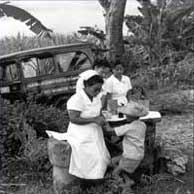| |
| |
 |

© UNICEF/ICEF0895 |
 |

A
boy is tested for tuberculosis in a rural part of the Philippines
in the 1950s. In 1952, UNICEF develops a 'cold chain' supply system
to keep vaccines cold — and potent --from manufacturer to recipient.
Experience in several African and Asian countries had shown that exposing
vaccine to high temperatures could make them ineffective.
  |
 |
| |
|
|
|
|
|





